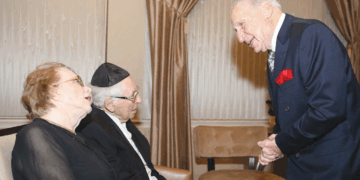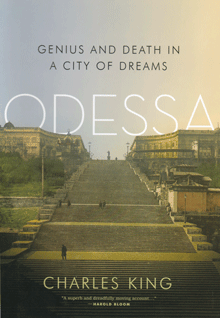Reviewed by NEAL GENDLER
Chances are pretty good that most of us, or someone we know, can trace a family member back to Odessa.
Famed Odessa, once Russia’s great enlightened and notorious port on the Black Sea — and still a city with a distinctive ambience — gained much of its pre-Communist flavor from its Jews, who were 36 percent of its population during World War I, behind only Russians at 39 percent.
Jews feature throughout delightful Odessa, Georgetown University professor Charles King’s easy-reading, engaging history of a city of contrasts that by turns was brightly cosmopolitan and darkly anti-Semitic.
Catherine the Great founded Odessa in 1794, on land relinquished by Turkey. She appointed as those lands’ developer her sometime lover, Grigory Potemkin — he of the hasty projects inaccurately known as “villages” installed to impress Catherine and her entourage as they boated down the Dneiper to view her new territories in 1787.
The city was designed in a tidy grid with governance and planning by western Europeans: Jose de Ribas, born in Italy, “son of the Spanish consul and his aristocratic Irish wife”; and the Duke of Richelieu, who fled the French Revolution and was named city administrator by Czar Alexander in 1803.
They created a city of unusual beauty, with tree-lined avenues, parks, an imposing opera house and a grand staircase from the harbor made famous in Sergei Eisenstein’s famed but mostly fictional movie, Battleship Potemkin.
Closer to Vienna and Athens than to Moscow, swarming with sailors and traders who brought cultures, ideas and epidemics, Odessa accommodated a mixed multitude — Russians, Jews, Greeks, Italians and others — residing in varying amounts of tolerance and contempt. By the early 1800s, Italians and their language were dominant; street signs were in Italian and Russian.
The city dominated early 19th century grain trading. But it also bore what King calls “a conflict between a self- image of openness and grandeur and one of insularity and terror.” Grand opera, artists and intellectuals thrived in an environment famed also for criminality. Acclaimed writers included Alexander Pushkin, Isaac Babel, and “shockingly articulate” Zionist Vladimir Jabotinsky, part of the city’s intelligentsia.
“When things worked, Odessa nurtured intellectuals and artists whose talents lit up the world,” King says in one of the strongest, best-written introductions I’ve read. “When they didn’t, the city’s name became a byword for fanaticism, anti-Semitism and deadly nationalism.”
Odessa was a magnet for eastern European Jews, King says, and by the 1860s, a quarter of the population was Jewish. Some made fortunes in grain, some lived in a slum, many were middlemen and small businessmen.
Although there was no ghetto until World War II, underlying European anti-Semitism oozed up in occasional pogroms. Then came the social devastation of World War I, the Bolshevik revolution in which both sides victimized Jews, the Communist years in which religious practice was restricted, and Stalin’s Great Terror, turning much of the nation into a society of informants and denouncers.
Railroads to carry grain, the Crimean War, the Suez Canal, World War I and Communism diminished Odessa’s commercial importance. World War II effectively eliminated its Jews. Odessa, in a strip of territory called Transnistria, was ruled by Romania with full Nazi zeal.
King estimates that up to 233,000 Jews — residents and refugees — were in Odessa before the Romanians arrived. Many joined the huge flight eastward; in autumn 1941, the mayor estimated 50,000 Jews remained. In November 1944, after several months back in Soviet control, officials counted 48.
Postwar, Jews did move in, but waves of emigration have created something of an Odessan diaspora, including the Brighton Beach section of New York that’s been labeled “Little Odessa.”
King’s superb writing stands on its head the stereotype of wearisome academic works, and his substantial bibliography reinforces his credentials for expertise. Readers also benefit from photos, regional and city maps, and a good index. Odessa is a lively, accessible history book that publishers would do well to emulate, both for sales and for reader enjoyment.
***
Neal Gendler is a Minneapolis writer and editor.




















Comments 7